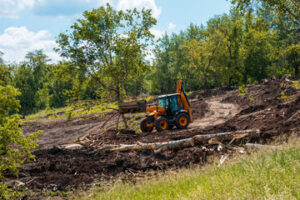Professional excavation contractors are essential in laying the groundwork for new construction projects. Their expertise includes digging foundation trenches, managing underground utilities, and clearing the land.

They also use specialized machinery such as excavators, backhoes, and compactors to efficiently and precisely prepare the site. This work requires a combination of strength and strategic planning to ensure the project is successful. For professional help, contact Bar T Excavation, LLC.
Professional excavation contractors are the first to arrive on a construction site and begin the crucial preparation process. These experts are responsible for ensuring the groundwork is solid and stable enough to support future building activities, managing underground utilities safely, and more. Using specialized knowledge and equipment, they carefully prepare the site according to the specific needs of each project.
For example, before excavation begins, they perform a series of soil tests to determine the load-bearing capacity and composition of the earth. They also evaluate the drainage capabilities of the land and install necessary infrastructure, such as sewage systems or utility lines. This helps minimize problems later on and ensures that all aspects of the new construction will be able to function properly.
Once the excavating contractor has tested the site, they will use the results to create a rough plan of action and identify any obstacles that may interfere with the project. They will then use a variety of machinery to clear, dig, and grade the land, preparing it for construction to begin. This includes machines like bulldozers, which are designed to efficiently level and clear land while minimizing environmental impacts. They can also utilize soil compactors to increase the density of the earth and improve its structural integrity, allowing it to support heavier loads.
When the groundwork is completed, an excavating contractor will then prepare the pad structure for foundation construction. This includes determining the right fill type, slope, and drainage to minimize condensation in the foundation, which can cause serious damage over time. Additionally, they will take into consideration the location of existing structures to avoid damaging them with heavy machinery.
In addition to preparing the foundation for construction, the excavating contractor will also ensure that all materials are stored safely and securely on the site before the start of work. This is important to prevent theft or unauthorized access to the equipment and can be done by installing fences, gate locks, or even erecting physical barriers around the site. In addition, they will utilize traffic control devices to direct the flow of vehicles and pedestrians throughout the construction area and implement erosion control measures to protect nearby properties from soil erosion.
Excavation
Excavation contractors go beyond simply “moving dirt.” They are deeply involved in the initial stages of a project, offering their expert insights based on soil analysis and topographical surveys. This helps ensure that the site will be able to support future construction efforts, and eliminates potential obstacles that may derail the process. They also use their experience to anticipate potential challenges and recommend effective solutions that will minimize safety risks, protect the environment, and optimize project costs.
During the excavation phase, they inspect and prepare the land for further construction activities. This includes removing debris and other materials, modifying the landscape to suit the design of a building or parking lot, addressing drainage issues, and laying foundations. They also perform rough staking to showcase designated areas where structures will be built, mark any obstacles that need to be removed, and more.
When hiring an excavation contractor, make sure that they have the necessary certifications and training. It is also important to inquire about their safety commitment and protocols, as well as their equipment and technology. Finally, it is a good idea to request a detailed estimate that clearly outlines the scope of work, timeline, cost breakdown, and other relevant specifics.
A well-executed excavation process is critical to a construction project’s success. Not only does it lay the groundwork for a strong and stable structure, but it also ensures that the project will be completed within the scheduled timeframe and budget.
Depending on the type of project, an excavating contractor may offer several different types of excavation services. Some of these include:
Other types of excavation services may include trenching: digging narrow, long trenches for installing pipes and cables; and grading: leveling the terrain to achieve the desired elevations outlined in the construction plans.
Proper drainage is crucial for minimizing water damage to asphalt pavement. When rainwater is allowed to pool in traffic areas, it can damage the surface and increase maintenance costs. During excavation, contractors can create channels that direct rainwater away from parking lots and driveways to avoid these problems. This is often an overlooked service, but it can be an invaluable one.
Integrating Vital Infrastructure
As a critical component of any construction project, excavating contractors play a vital role in creating the foundation for new structures. During this stage, they dig trenches or pits to the appropriate depth and dimensions while adhering to strict safety standards. They also sift through soil to identify any potential risks or hazards that may interfere with the project’s progress and make sure they are properly addressed.
When digging through large tracts of land, excavation contractors are often responsible for laying important utilities like water, gas, sewer, and electrical lines. To do this, they must first notify local utilities providers so that their personnel can come out to mark all utility lines before work begins. With this knowledge in hand, excavation contractors can avoid accidentally hitting and damaging these valuable assets, saving both time and money for the client.
The integrity of any excavation site depends heavily on a well-planned drainage system. Without adequate water management, excavated soil can become unstable and prone to collapse. This can cause significant delays and add substantial costs to the overall project. Experienced contractors can help ensure the stability of any soil by implementing drainage solutions that minimize damage caused during excavation.
Another key element of the excavation process involves installing and monitoring excavation support systems (ESSs). ESSs prevent soil movement during construction, either temporarily or permanently. They are designed with specific factors in mind, including soil type, groundwater conditions, and excavation site location. For example, cohesive soils can be supported with less immediate shoring while granular soils require more robust ESSs.
When digging near existing roads, railways, or buildings, the excavation contractor must also take into account surcharge loads, which can increase the pressure on the shoring walls and necessitate stronger ESSs. Additionally, any permanent ESSs must be carefully engineered with corrosion protection to ensure long-term durability in a marine environment.
Final Grading
In a new construction project, homeowners and builders must make a million decisions. The lion’s share of these focus on the interior of the new building, including floors, light fixtures, wall colors, toilets and bathtubs, appliances, and so on. But there are also vital exterior considerations, like grading the land and installing drainage systems to prevent flooding and soil erosion.
Professional excavation contractors are responsible for preparing the site to accept the foundations and other structural elements of the new building. This requires a great deal of knowledge about earthmoving equipment, safety regulations, environmental controls, and more. It’s a highly complex, physically demanding task that plays an important role in the stability and success of any construction project.
Excavating contractors begin by conducting a survey of the land to determine its composition and load-bearing capacity. This information is then used to shape the land according to the specifics of the project’s design. Grading machines are then employed to achieve precise leveling. This helps to eliminate unevenness that can lead to shifting or settling of the foundation. It’s also essential to ensure the site meets specific grading requirements set out in the project’s design.
Fine grading is a process that can only be accomplished with the right equipment and experience. In some cases, this means laser-guided graders or skid steers with grading attachments. In others, it may mean the use of hand tools to accomplish smaller, more delicate tasks. It is also critical to conduct a pre-grading survey, which establishes accurate benchmarks that are referenced when establishing elevations and slopes on the final product.
A properly graded lot is crucial to the long-term health and function of your home or business. Getting it wrong from the start can result in flooding and drainage issues, which can cause significant structural damage to your property. For this reason, it’s vital to enlist the help of an experienced excavation contractor to handle all your site preparation and grading needs.
